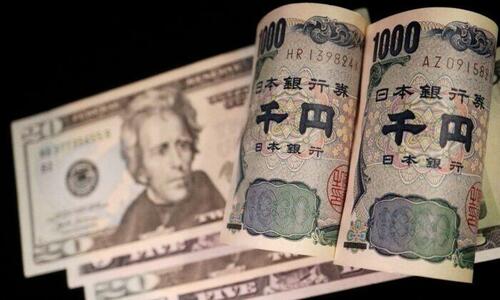
Japan’s Warning For America
Authored by Michael Wilkerson via The Epoch Times,
Last week, Japan saw its currency, the yen, rapidly depreciate against the U.S. dollar and other world currencies to near record low levels. This drew the attention of financial markets and other observers, and—in some quarters—led to panic. There was concern that Japan, a formerly great nation now increasingly viewed as the “sick man of Asia,” was on the brink of a currency and financial markets crisis.

It wasn’t so long ago that Japan was the envy of the world. Japan’s postwar recovery and subsequent economic miracle produced by the 1980s the world’s second-largest economy after the United States. Numerous Japanese multinational corporations were admired by the business world as a result of their growth, efficiency, and managerial discipline. The state and big business were closely aligned in what appeared an unstoppable formula. Flush with cash and confidence, Japanese companies and investors were aggressively expansionist, acquiring market share, trophy properties, resources, and businesses in the United States and elsewhere. Much like concerns about China today, fears then abounded that Japan would overtake the United States as the global economic leader.
These fears were unfounded. “Japan Inc.” was a house built on a faulty foundation. Overly accommodative easy money, along with high leverage throughout the financial and corporate sectors, facilitated a massive stock market and real estate bubble, which eventually burst in 1990. The crash led to a depression from which Japan has never recovered, even after three decades. The question is, why not? Herein lies a lesson for the United States.
Repeated government bailouts of failing financial and industrial companies have perpetuated Japan’s crisis. Japan’s leaders and policies have repeatedly blocked the process of creative destruction, which—if allowed to run its course and cleanse the system—would have been a massive stimulus to entrepreneurship and economic vitality. However, rather than allow capitalism to work, the Japanese system doomed the country to a generation of stagnation.
As a result, Japan has endured three “lost decades” of weak economic growth, diminished purchasing power, lower and lower standards of living, loss of prestige and influence in the global community, and an aging population that the island nation’s resources are straining to support.
Japan now has the world’s highest government debt-to-GDP ratio, at 264 percent. Japan’s banks are walking zombies, unable to grow or lend because they have never restructured their balance sheets to clean up massive piles of debt left over from excesses of previous decades. The Bank of Japan (BOJ) holds government bonds and other assets equal to 127 percent of Japan’s GDP, the highest ratio of any central bank in the world. This portfolio resulted in over $70 billion in unrealized losses for the BOJ in six months of 2023 alone.
The Japanese yen has devalued against the U.S. dollar by more than 30 percent in just three years since 2021. Since the global financial crisis 2008–09, the yen has lost 75 percent of its value against gold. Because of Japan’s high reliance on imports, this loss of purchasing power has translated directly into a substantially lower standard of living for the Japanese people. In theory, Japan could support the yen by raising interest rates, but this is a political, monetary, and fiscal impossibility.
Decades of easy money policies are a central culprit and cause of this slow-moving trainwreck.
The Bank of Japan only began raising interest rates this March, some three years after the United States and the European Union brought their own easy money policies to an end. This was the first time the BOJ has raised rates since 2007, a move that pulled the official rate out of negative territory. Nonetheless, with inflation now approaching 2 percent, a short-term policy rate of zero to 0.1 percent means that real rates remain around negative 2 percent. This serves as an additional tax on Japanese households and an intended stimulus to spend today rather than save for tomorrow.
Money essentially is free in Japan, but no one can afford to borrow it, even if the banks can manage to lend it. The BOJ and the entire banking system stand in the penumbra of insolvency. Only Japan’s decade-long zero interest-rate policy has allowed Japan’s decrepit financial system to continue to stand following the 2008 financial crisis and the effects of COVID economic shutdowns. Japan cannot afford to raise interest rates to support its currency more than nominally above the zero bound without substantially raising debt service costs and exploding losses. This would bring the entire rickety system to the ground.
A growing economy might help ease the burden, but Japan’s economy is moribund. This is not surprising, as meaningful growth is impossible under mountains of debt. GDP shrank by 0.8 percent in the third quarter and eked out 0.1 percent growth in the fourth quarter. While the country thus barely escaped technical recession (two consecutive quarters of GDP decline), Japan hasn’t posted GDP growth above 2 percent in more than 20 years, save for two rebound quarters after the global shocks of the financial crisis and COVID.
Japan represents a slow-moving demographic disaster. Japan has the oldest median population of any major country in the world and the lowest fertility rate at 1.37. Japan’s fertility rate has been below the minimum population replacement rate (2.1) for 40 years, meaning that the country is both aging and losing economic productivity, and it is probably too late to reverse it.
This all represents a grave warning to the United States.
The U.S. government is chasing Japan for the ignoble title of most indebted nation. Overly indebted nations cannot grow. With federal government debt to GDP of 129 percent, a ratio which is increasing rapidly, the United States is now the fourth most indebted country in the world. Debt is growing more quickly now because the federal government refuses to wean itself off of deficit spending, including an additional $1.7 trillion in 2023, which must be funded by new debt, as must over $1 trillion in interest expense. This debt—and the cost to service it—acts as a drag on our economy. Deficit spending and the borrowing required to support it crowds out private market investment and financings.
Rather than let more insolvent banks and unprofitable firms fail, U.S. monetary policy since at least the 2008 financial crisis has propped up bad business models—and the asset values of otherwise worthless investments—by subsidizing the cost of capital well below the natural rate of interest. In a nation that has been the standard bearer and exporter of capitalism for more than two centuries, socialistic government policies are preventing capitalism from working at home. This will eventually catch up with our financial markets and economy, just as it did for Japan.
It is not just shortsighted monetary and financial policy that threatens U.S. competitiveness.
If Americans’ worsening attitudes toward the importance of marriage and children do not reverse course dramatically, the United States will face the same demographic fate as Japan. The fertility rate in the United States has been in decline since at least 2008, and reached a record low of 1.62 in 2023. This is well below the replacement rate, and thus unsustainable.
Progressives point to declining fertility rates and aging populations to justify mass illegal immigration, but this is a red herring. Bringing tens of millions of unskilled, uneducated, and culturally unassimilated migrants into the nation is not a benefit but rather an untenable burden on social infrastructure, an enervating drain on economic productivity, and an unbearable tax on legal citizens.
At least Japan got that part right.
Tyler Durden
Wed, 05/01/2024 – 23:05

 1 rok temu
1 rok temu







![Święto Wina 2025 – dzień drugi: historyczny korowód, konkursy i występy gwiazd [fotoreportaż]](https://www.roland-gazeta.pl/media/k2/items/cache/b4e45d70655fb708eb982278bff16c04_XL.jpg)
